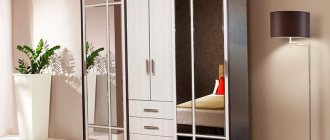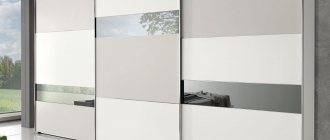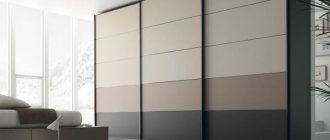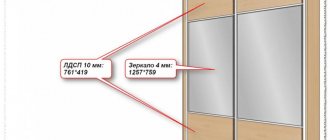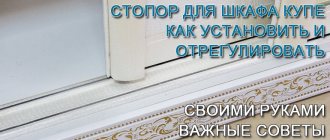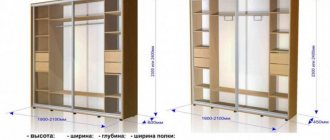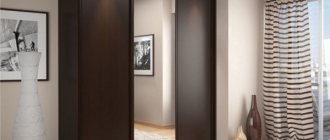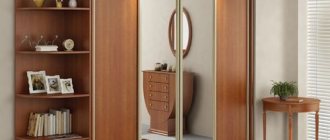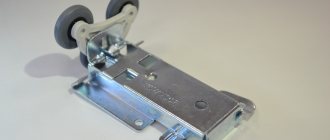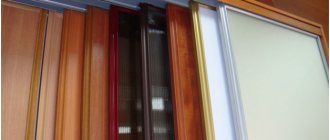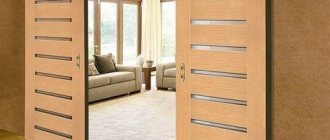The door is not tightly adjacent to the wall, moving away from it
This often occurs due to damage, displacement or absence of the so-called stopper. It is a thin double metal plate, the upper part of which is divided in half and the ends are slightly bent upward, as in the photo. This part is installed in the middle of the bottom of the groove in which the door is held.
- To work with the stopper, you will have to remove it - otherwise you won’t be able to get it out.
- When restoring the location, replacing and installing in the absence of this important part, it is enough to fix it in the right place using reliable glue; more often, superglue is used.
How to remove a wardrobe door
Let's consider the features of analyzing several variants of models: economy class, mid-price category and expensive models. Most of the doors of such cabinets, usually located in the middle price category, have stoppers on the sides that limit movement. Before carrying out work, we find them on every door that requires replacement or removal.
- Unscrew the upper and lower stops.
- We put the screwdriver aside; we won’t need it for now. We close the doors and approach the one that needs to be removed.
- Holding it by the side, lift one of its upper edges up, and use a screwdriver to remove the lower edge from the groove and pull it towards you.
- Gradually, lightly pulling, we release the entire lower side from the groove and lower it to the floor, thereby freeing the upper edge.
- We take the top edge out of the groove and remove the entire canvas.
- Economy class models are rarely equipped with stoppers: as a rule, the rollers simply ride on guides, which have movement limiters on the sides. Therefore, in such models it is enough to remove the stops with a screwdriver and roll the door off the rails.
- Very expensive models are equipped with closers, so before you take on the main work, unscrew the closer mechanism on one side, leaving it attached to the wall or ceiling of the cabinet. This will save time on assembling the entire structure after completion of the repair work.
- Be careful when working with mirrors and never hold a screwdriver in your hands or teeth, so as not to injure yourself, damage the mirrors or leave scratches on the furniture.
What causes the door to pop off?
If a person finds that even after correct adjustment he has certain problems with the cabinet and rollers, then he needs to solve the problem and re-adjust the structure himself.
The most important thing is to determine the reason why the door jumps off the tracks. This could be due to either poor assembly or incorrect placement of the doors. The most common reasons why doors begin to fly off include:
- Door warp.
- Peeled off tape if the design was on it.
- Loose fasteners.
- Penetration of foreign objects into the frame rails.
- Sharp manipulations on the part of the owner.
Each reason is solved by its own setting.
Door distortion
First you need to remove the buffer tape, and then you need to insert a key into the lower hole intended for adjusting the position. Next, the direction is determined. At this time, you need to pay attention to the position of the door. By rotating, you can adjust the skew and correct it.
To understand that the door is in the correct position, you need to make sure that the door leaf is adjacent to the side post. After this, the web is held in place using a stopper. You need to continue adjusting until the very end.
Peeling off the tape
You can restore its position using:
- filling it into the hole;
- applying glue;
- clothespins.
The best option is clothespins. The first option will help those who have a fairly long ribbon. The second one is for neat people, since the glue should not seep into the holes. Clothespins will help secure the correct wedge.
Weakened elements
Weakened parts can be heard. As a rule, the doors begin to make annoying sounds. To correct the situation, parts are tightened or completely replaced.
Advice! It is worth selecting replacement elements from the same manufacturer.
Foreign objects
Various foreign objects, including pieces of paper and stones, could have gotten into the rails themselves. They need to be removed. This can be done with a vacuum cleaner or with your own hands. After this, the door will move normally and you won’t even have to adjust it.
External factors
If you constantly close and open the door, you can break the mechanism and parts of the structure. To prevent this from happening, you need to work carefully with the cabinet doors.
When a cabinet door breaks due to harsh actions, the parts need to be replaced. Replacement occurs in the same way as for any other part.
This way you can adjust the wardrobe. After adjustment, the owner receives a high-quality structure that can last for many years. The main thing is to find out the cause of the interference, and also initially correctly adjust the direction.
The door came off the guides, the rail
This is quite common. To eliminate the problem, just slightly lift the door, insert the roller into the groove, and lower the door.
To prevent further slippage from the door guides, inspect the stored items, remove those that touch it and interfere with opening and closing. Don't use too much force to move it.
The door extends from the wall of the wardrobe at the top or bottom
What to do if one of the ends of the door does not fit tightly against the cabinet wall? In this case, you need to adjust the tension of one of the furniture bolts that secures the door.
- To eliminate the distortion, we find two holes on the aluminum door frame. Please note that they may be hidden with furniture tape.
- We need the hole that is closer to the bottom edge of the door. There is a hex screw hidden there that regulates its position. The second screw is responsible for fastening the door frame.
- Using a furniture wrench or a hex screwdriver, we begin to adjust the position: if the top edge comes off, gradually turn the screw counterclockwise, if the bottom edge moves clockwise. Before our eyes, the distortion disappears, the gap disappears.
Should you repair the wardrobe yourself, call a repairman or buy a new one?
When renovating an apartment or some other situations, there is a need to replace cabinet doors due to a violation of their functionality. Or there is a simple leak, and the entire cabinet body becomes unusable. However, often simply reducing the height of cabinet doors can solve the problem that arose during an apartment renovation, when the height was reduced due to the installed tiles or laminate. Either the rollers broke when dismantling the cabinet, or were completely lost during the move. It is the breakdown of wardrobe doors that is the most common reason that forces owners to order new sliding doors or an entire wardrobe.
Repairing sliding wardrobes at home is a very common service that the craftsmen of our furniture company have to resort to daily, fulfilling from three to five orders for sliding wardrobe repairs. Therefore, it is better not to complicate the situation with simple repairs due to ignorance and inexperience; it is better to turn to professionals for whom this is a simple job.
With the exception of simple door breakdowns, such as replacing the roller mechanism (if, of course, an original replacement is found), the following repair procedures may be necessary:
- repair of a deformed guide;
- replacement of cabinet body elements;
- level adjustment of facades in two planes;
- replacement of drawer guides and baskets;
- pantograph replacement
- cabinet frame reinforcement
- modernization of internal filling
- replacement of the sliding system.
In St. Petersburg, our craftsmen work in all districts of the city and can repair sliding wardrobe doors at home, repair interior sliding doors, and replace mirrors in wardrobes. The repair services they provide include many types of furniture repair work, which will not be difficult for our craftsmen to complete: replacing furniture fittings, lifting mechanisms, strengthening furniture frames, making custom-made furniture and much more. Call: 8 furniture production 8 furniture repair
Grinding noise when door moves
This is due to the weakening of one of the upper rollers of the wardrobe. You need to remove the door, adjust the roller or squeeze the profile handle from above, which will allow you to achieve the same overhang on both sides.
The closet door has stopped moving smoothly and is sticking
It's easy to adjust. There may be several reasons for this:
- Dirt has accumulated in the guide or the roller has threads, hair and dust wrapped around itself, so it is difficult for it to roll.
- It may break, become deformed, or lose edge support during prolonged use. This is more common in economy class products with an aluminum profile.
- You can adjust the cabinet roller yourself. It is enough to unscrew the hexagonal screw located under the brush at the very bottom of the door, remove the roller, inspect and fix the problem.
As you can see, adjusting the wardrobe door mechanisms is not such a difficult task; you can fix everything yourself. It is important to find the cause and eliminate it. And if you have any questions, watch the video, which explains everything clearly and clearly.
Buying a wardrobe for a bedroom or hallway is a popular solution for storing things. With proper use, this furniture lasts a long time, problems with it rarely arise. But over time, the moving parts of the doors wear out and wear out without proper care. Because of this, sliding doors warp, open poorly, and jam. Some breakdowns require the presence of a technician, but many can be fixed on your own. Let's look at what wardrobe malfunctions you can fix yourself.
Content:
Types of breakdowns and ways to fix them
When a wardrobe with sliding doors breaks, there is no need to rush to call a repairman. Most often, you can find the cause and solve the problem yourself. In most cases, furniture repair is needed due to the following:
- elements of the body or its filling are broken;
- parts of the valve opening mechanism are deformed, worn out, torn off, or loose;
- glass and mirror elements of the facade are broken or damaged.
Premium sliding wardrobes are often decorated with carved decor and various moldings. If furniture is not used carefully, they chip, scratch, or break off. After this, their restoration is necessary.
How to properly assemble a wardrobe with your own hands, step-by-step tips
Frame defects
During long-term use, the furniture body warps and becomes deformed. It begins to wobble and squeak when the doors move. Sliding door leaves and drawers open with difficulty or become completely jammed. The problem is a broken or loose fastener. Here you need to inspect the wardrobe box and find problematic screws, screws, bolts. Then replace or tighten them with a screwdriver or screwdriver. Additionally, it is recommended to securely fasten the frame iron corners fixed at the joints of the rear wall of the cabinet and both side walls.
The most common cases of failure of wardrobe filling elements:
- Deflection, breakage of shelves, formation of large cracks on them. The cause of these defects is excessive mechanical stress. It occurs if the base of the storage system is too wide and not reinforced with racks. Panels that are sagging or broken in half cannot be repaired; only their replacement is possible. The new shelf needs to be divided into two compartments and placed in the middle with timber supports to reduce the load.
- Chips and small cracks on shelves and drawer fronts. These small damages are restored. All defects are covered with wood putty, sanded with fine emery cloth and covered with paint to match the furniture.
- Deflection, separation from the walls of clothes rails. This happens due to strong mechanical loads. First you need to strengthen the pipe in the middle, this is done using a pass-through holder. It is fixed to the inside of the cabinet lid with screws. Then a rod is threaded through the fittings ring and secured with two flanges on the sides of the furniture.
When using the product, the filling elements break: hangers, hangers, hooks. The fittings also fail: handles, latches, awnings. One of the furniture legs may give way. When repairing wardrobes, these elements are completely replaced.
To prevent the shelves from sagging, you can install timber supports in the middle, which will reduce the load
Chips and small defects on the surface of the shelf can be covered with wood putty, treated with fine sandpaper and coated with paint to match the furniture
If the clothes rail breaks, reinforce the pipe in the middle using a pass-through holder
Damage to mechanical components
If the furniture door moves with difficulty, and there are gaps between it and the body when closing the door, this means that there are problems with the sliding system. They arise due to:
- dirt in the frame groove;
- unreliable fastening of the guide on the box;
- incorrect location of the stopper;
- deformation, wear of wardrobe wheels.
Review of the main models of sliding wardrobes, tips on selection and placement
First of all, the lower frame of the sliding system is inspected for contamination. If they exist, they are removed like this:
- First, dust is collected with a vacuum cleaner;
- then the stuck dirt is removed with a scraper;
- Lastly, the gutter is wiped with a rag soaked in soapy water.
Gaps often form between the doors and the frame of the furniture. This indicates deformation of the case or problems with the stopper. When a gap appears at the junction of the canvas and the central section of the structure, this indicates that it is overloaded. Sometimes the retainer falls out of the groove of the bottom guide, in which case it just needs to be inserted back into the profile. It is advisable to secure the stopper additionally. This is done using screws or Moment construction adhesive.
In some cases, the frame of the sliding system lags behind the frame. Here you need to remove the sash from the guide, then screw the profile with self-tapping screws to the body through new holes drilled with an electric drill. Next, the canvas should be put in its place.
Dirt accumulated in the groove of the frame can lead to problems in the operation of the sliding system
If the retainer has fallen out of the groove of the lower guide, then you just need to insert it back into the profile
If the frame of the sliding system lags behind the frame, you need to remove the sash from the guide, and then screw the profile with self-tapping screws to the body
Door deformation
A sash that creaks, rattles, or jams when moving indicates that the roller has become deformed or the rubber layer covering it has worn off. In this case, the wheel needs to be changed. Before doing this, you can try lubricating the sliding mechanism with technical oil. If this does not solve the problem, drastic measures are needed.
If the doors no longer close completely, are skewed, or deformed, the source of the problem is first determined. It may be that the furniture is overcrowded with things and some of them interfere with the door, so it is necessary to inspect the structure. If the assumption is not confirmed, the wardrobe is repaired with the replacement of rollers and guides. This is done as follows:
- Lift the door, pull out the lower wheels from the guide, then move the lower part of the canvas and pull it out of the upper profile.
- Turn the screw at the bottom of the facade using a hexagon.
- Remove the rollers and install new ones using a hexagon.
Purpose of rollers for sliding wardrobes, methods of installing elements
Remove the door by pulling the wheels out of the guides
Using a hexagon, turn the screw at the bottom of the facade and remove the roller
Install new components
Return the door leaf to its place
The procedure to follow if gaps appear between the canvas and the furniture body:
- the buffer tape in the corner of the facade comes off;
- the screw rotates clockwise, thereby removing the lower gap;
- when the gap is at the top, the fastener rotates in the opposite direction.
Wardrobe doors may not close tightly due to a broken stopper or latch. If the latch falls out or moves, it is inserted back. To ensure reliable repair of wardrobe doors, it is mounted on quick-drying glue. A broken lock is completely replaced.
Retainer repair
Mirror replacement
Over time, fragile decorative elements of furniture facades are scratched, cracked, broken, and their amalgam is peeled off. In this case, the wardrobe mirror changes. The procedure is as follows:
- The sash is removed from the guide and laid on the floor.
- Using a screwdriver or screwdriver, the insert frame is disassembled. It is made from an aluminum profile and is fastened with four screws located at the end of the blades. Also, the frame is made of iron and is held in place by roller clamps, which are located on the inside of the sash.
- The dimensions of the insert are measured. This must be done precisely down to the millimeter.
- The part is ordered from a furniture shop or glass factory.
- When the item is delivered, they begin replacing the mirror in the closet. To do this, it is inserted back into the frame, which is screwed to the door.
- Lastly, the blade is mounted on the guide.
You must work slowly and carefully with the fragile insert. If handled carelessly, it may break. It is advisable to immediately stick a special protective film on the back of the mirror.
Despite the reliability, strength and rigidity, the wardrobe often fails during operation. If the breakdown is simple, then it is easy to repair it yourself. The main thing is to do everything according to the rules.
Disassemble the insert frame, measure its dimensions and order a similar part
Install a new mirror into the frame and install the door leaf on the guide
Why is the wardrobe crooked?
If you can see with the naked eye that the door looks like a curved propeller, this is a factory defect. It needs to be changed. If the defect has arisen over time, then you should know that when the doors are opened frequently, backlash often occurs, which is why one of the doors sags. For this reason, the door leaf warps. To fix the problem, you need to adjust the rollers. There are long screws at the bottom on both sides of the doors, usually hidden under adhesive soft tape. It is moved aside and the screws are tightened so that the door is horizontal to the floor.
Sliding wardrobe – repair of sliding doors
If your closet doors begin to open with difficulty or even jump out of the guides when opening and closing, then the problem lies specifically in broken rollers. True, it is not necessary to change them in all cases, because they may not be broken. The thing is that the rollers, after some time, inevitably become clogged with dust, hair, dirt, fluff, pet hair, etc. To clean them, simply lift one side of the cabinet door all the way up and place a hard object underneath it. If cleaning does not help, then you need to replace them if, during cleaning, you see that they are deformed, broken or have a crack. To do this, you need to completely remove the doors from the guides. All systems are completely different, how and which one to disassemble when buying a cabinet is another story; in practice, any independent repair of sliding door doors in most cases has the opposite outcome, for this reason we advise you to contact sliding wardrobe repair specialists.
How to repair a Stanley wardrobe or its equivalent if the door is jammed in one position? If the symptom in the sliding wardrobe is exactly like this, it means that the problem lies in the sliding door guides. Apparently a plug has formed in the runners and the stopper on the base of the roller housing is jamming in place of the formed plug of dirt and dust. In this option, it is necessary to remove the doors from the guides and clean the guides. The rollers in the wardrobe can be easily changed. So if you do not have an Italian, German or Czechoslovak wardrobe with a hanging system, then no problems should arise, the main thing is to repair the wardrobe slowly, having figured out how and what to do.
Possible breakdowns of sliding doors
Sometimes the mirror in the closet breaks. If you have a broken or cracked mirror or colored glass in a compartment door made of steel or aluminum profile, then:
- Carefully disassemble the compartment door frame one by one, preferably on a flat surface;
- We take out the broken glass more than carefully so as not to cut ourselves;
- A new mirror or glass is ordered;
- We install new glass or mirror;
- We assemble the frame in the same order as we dismantled the door;
- If parts of the door frame are bent (usually in a steel system), they need to be carefully measured, purchased and replaced with new ones. The aluminum system is secured with ties, and the steel system with upper and lower roller housings. When replacing compartment door parts, steel systems will not have mounting holes; they will have to be fastened with self-tapping screws.
In general, the ideal option when repairing the roller system of a sliding wardrobe is to call a wardrobe repairman. If you decide to repair the sliding wardrobe yourself, then:
- If the rollers are broken, replace the damaged rollers with new ones.
- If your cabinet is more than five years old and a steel system similar to Komandor, Stanley, Kirena is used in its manufacture, then it is better not to clean the rollers, but to immediately replace them with new ones. If they are original, then cleaning the rollers is enough, since branded rollers last more than ten years.
- The aluminum RaumPlus system will last more than twenty years without problems if the guides are periodically cleaned. If you have an analog system, then you need to change the rollers. In practice, unscrupulous furniture manufacturers violate the assembly technology of aluminum compartment doors, and as a result, it is not the rollers that break. In such cases, you cannot do without a wardrobe repair specialist.
Now you know the options for breakdowns and how to fix the wardrobe yourself. It is rare to encounter such a breakdown in furniture that could not be corrected with your own hands and improvised tools, which are found in almost every home. Ideally, use the services of our specialists in repairing domestic and imported wardrobes. Our craftsmen can easily replace broken mirrors in compartment doors and repair compartment doors in Italian, German, Czechoslovakian and Russian wardrobes.
Call a specialist by phone 980-36-42
When should you repair your sliding door?
Sliding doors are doors with rollers that slide between two horizontal tracks. The lower rails guide the movement of the panels, and the upper ones hold the sashes and prevent them from falling out. Roller door structures operate silently, save space and decorate the interior.
Repair of sliding interior doors is inevitable if the device is not promptly prevented. Cleaning the guides, lubricating the rails and adjusting the movement of the shutters will extend the life of the structure. Signs of faulty roller doors:
- subsidence of the canvas with subsequent damage to the floor covering;
- extraneous noises, creaks and knocks during operation;
- loosening of fasteners;
- deformation of the valves;
- tight fit into the door frame.
Common problems
Operating the sliding system without regular maintenance leads to wear of the parts. The following problems appear:
- The movement of the doors is accompanied by clicking, knocking or creaking. The reason is worn out rollers or a bent rail. To eliminate noise, you need to remove the canvas and inspect the structure. The guide is bent so that the space for the door expands. If the problem is in the wheels, they are changed.
- The doors were deformed. When the structure becomes warped immediately after installation, it must be replaced. This is a factory defect. After long use, the sashes sag due to the divergence of the holding screws. They are twisted, and the canvases are placed in a horizontal position.
- The door opens on its own. The reason may be loose fasteners or a curved floor surface.
- Preventing contamination of the device (dust, hair, small objects) will extend the life of the sliding system.
The door doesn't close tightly
Due to uneven floors, the door structure may become skewed. When closed, the doors do not fit tightly together. Gaps form near the vertical posts through which extraneous odors and sounds pass through. Using a level, adjust the clamp, securing the blades in the desired position.
If the door does not close due to one-sided sagging of the sash, adjust the rollers. There are 2 holes at the bottom of the canvas. Through the upper hole, access is provided to the fastening screw, and through the lower hole, to the adjusting screw. Use a hex wrench to turn the screws to raise or lower the wheel.
The structure may not close completely due to a broken stopper. The dropped or displaced latch is returned to its place. For reliability, fix it with durable glue.
The door does not slide on the guide
In order for the sliding door to open easily and stop jamming, you need to improve the operation of the rollers and grooves. Dust, hair and other debris prevent normal sliding. The doors are removed, all parts are cleaned with an alcohol-soaked cloth and reinstalled. If the situation has not changed, the reason is worn out wheels. They should be removed using a hexagon and replaced with new ones.
To improve sliding, do not lubricate the mechanism with oil. Machine oil contributes to the accumulation of debris and dust. Sunflower - gradually thickens and makes it difficult for the canvas to move. The rollers and rails will have to be replaced.
Main types of faults
Extraneous noise
One of the main advantages of sliding doors is the light, smooth and silent movement of the shutter. As a rule, any malfunction of the sliding mechanism leads to the appearance of extraneous noise, which in turn signals the appearance of a malfunction in certain structural units.
For example, unpleasant sounds (rattling, grinding, squeaking) when moving the sashes are in most cases due to either contamination and insufficient lubrication of the moving elements, or loosening and loosening of the fasteners of the roller mechanisms, or simply due to their critical wear.
To eliminate this kind of problem, first of all you need to remove the door leaf - this is done quite simply.
You need to slightly lift the flaps and use a flat screwdriver to press the lower rollers, and then lightly pull the leaf in your direction so that the mechanism goes beyond the bottom rail. After this, carefully, without applying unnecessary physical force, so as not to bend the upper guide, the canvas smoothly lowers to the floor at a slight angle. Assembly is carried out in reverse order. The process is shown schematically in the figure.
If the design uses a top-support system, then the door is removed by removing the fasteners. In this case, it is recommended to have an assistant to hold the canvas.
After direct access to the mechanism is obtained, first of all, the degree of wear of the rollers is checked and, if necessary, replacement is made. If this is not required, the parts should be cleaned of dirt and the moving elements should be lubricated. Then, to prevent the canvas from skewing, the rollers are leveled along the vertical overhang (i.e. when the door is in the working position), and the fasteners are securely tightened.
Misalignment and loose fit of compartment doors
As already mentioned, in most cases, the first signal of a violation of the proper functioning of sliding doors is the occurrence of extraneous noise, which, depending on the degree of neglect of the malfunction, will increase, both in intensity and volume level. However, there are situations when the problem can only be detected by visual inspection.
The use of excessive physical force leads to imbalance of the roller mechanism - the correction screw responsible for the vertical orientation is loosened and unscrewed, as a result the door leaf is skewed, the leaves begin to fit unevenly, and a gap is formed. Provided there are no accompanying unpleasant sounds, adjusting sliding wardrobe doors with rail motion can be done quite easily with your own hands.
In order to get to the adjusting screw, you need to peel off the sealing (buffer) tape from the side end near the roller - under it there will be two holes for a hex key (usually the top one for assembling the door, the bottom one for adjustments). Accordingly, in order to level the structure, it is necessary to rotate the key clockwise or counterclockwise (one full circle = 1 mm).
Spontaneous opening
Another common problem with prolonged use of sliding doors is spontaneous rolling back of the door. The reason lies in the incorrect position or wear of the locking stopper (positioner), which is presented in the form of a rigid metal spring and is most often located inside the lower guide (maybe on top).
In order to adjust the locking mechanism, it is necessary to press the door firmly against the side panels of the cabinet and make a mark with a pencil on the rail in the place where the center of the roller is located. Then the blade is moved to the side, and using a thin screwdriver or any other device, the positioner is moved so that its middle is at the level of the mark.
If the locking element is subsequently moved to another position, it must be additionally secured with glue or small nails. If the door still cannot be fixed and it still moves spontaneously, you can try:
- straighten the antennae;
- strengthen the system with an upper self-adhesive stopper;
- purchase a new, stiffer element.
Doors falling out
Another annoying breakdown is when the door leaf partially falls out of the guide profile, most often only the bottom one. There may be several reasons for this situation.
The most common is that the rails are contaminated with compacted dirt and small debris. As a result of the natural movement of the sash, the movement of the sash is disrupted, the wheel rises and flies out in the direction of least resistance. This situation can be prevented by regular cleaning of the structure.
Also, the door can jump out of the guide if excessive force is applied when opening/closing, since with sufficient acceleration of the door, the locking mechanism turns into a springboard. In order to prevent this, it is necessary to make all movements carefully without any harshness, and as an additional measure of protection, you can reinforce the upper tire with auxiliary positioners.
The most common cause of failure is ignoring any malfunctions at the initial stages and, as a result, destruction of the main mechanisms. To restore the functionality of the system, it is necessary to remove the door leaf, identify the defective unit, restore/replace damaged parts, and only then perform reassembly and subsequent adjustment of the sliding doors.
Recommendations
The rules for using a wardrobe are standards and are not much different from tips for using other furniture. In all cases, it is necessary to show care and accuracy, not to make sudden movements or use excessive force. It is recommended to carry out regular maintenance, cleaning and lubrication of sliding elements, as this allows you to increase the service life of the structure many times over.
If minor damage occurs to a sliding wardrobe with a rail track, in most cases you can fix it yourself by adjusting the doors. However, in conditions of failure of entire mechanisms or load-bearing elements, you should definitely contact specialists.
Features of repair depending on the design
In accordance with customer requirements, 2 types of structures are installed: with and without a pencil case. Each type of repair has its own characteristics.
Door with pencil case
The design with a pencil case is similar to a video cassette. During installation, the inner part of the wall is removed and framed in a rigid box. A sliding system is installed inside. The canvas slides into the freed space like a cassette that is hidden in a box. The resulting recesses are covered with sheets of plasterboard, and then with finishing building materials - plaster, paint or wallpaper.
What to pay attention to when repairing
Incorrect installation of the guides complicates the operation of the sliding system mechanism. The doors do not open so quickly, periodically falling out of their grooves. When installing the guides, you need to remember that the lower part will accumulate debris. There are sliding structures without bottom rails - they last longer because the likelihood of clogging the mechanism is minimized.
Two guides are important when reliable sound and heat insulation is needed between rooms. When replacing handles, take into account their shape: the protrusion of the fittings beyond the surface of the door should be minimal.
Replacing the roller mechanism
The number of rollers may vary depending on the mass of the sashes. Different models have different load capacities. They are made of metal or plastic. Under the influence of constant friction, plastic rollers wear out or crack. At the same time, the axle on which the wheel is attached may become thinner. Any repair methods do not give results (for example, gluing, securing with tape), so the roller mechanism must be replaced.
There are types of wheels with rigid mounting that cannot be repaired. After some time, such a node completely produces the intended resource. The moment of necessary replacement of the mechanism is determined by the degree of sash subsidence.
A large assortment of rollers makes it difficult to select them. In order not to make a mistake when purchasing, it is recommended to take one wheel to the store for comparison. In shower stalls, the upper and lower wheels often differ in size, so take both mechanisms with you.
Replacing guide rails
The rail mechanism includes upper and lower guides - these are panels along which the doors move. For light structures, one rail is sufficient; heavy doors are secured using two guides. This prevents the web from moving to the side.
Do not resort to replacing the rail mechanism in case of contamination of the grooves. To clean them, remove the doors and remove all debris from the grooves. The work is performed with a sharp thin tool (screwdriver, knife). The cleaned guides are degreased and the sashes are installed in place.
Stoppers on the rails prevent the doors from extending beyond the structure. When they break, the door does not fit tightly to the frame or opens spontaneously. The malfunction is eliminated by adjusting the latch.
Most often, replacement of rails is necessary for sliding automated systems. Such structures are installed in technical rooms and shops, so the grooves quickly become clogged with dirt and debris.
Repairing sliding doors does not require any special skills. Accuracy and the availability of the necessary tools are important.
possible wardrobe malfunctions and their elimination
First you need to decide on the design of the cabinet - its constituent elements. The repair of each element has its own specifics.
The wardrobe consists of:
- Frame (side walls or false panels made of laminated chipboard 9-10 cm wide. If the cabinet is not built-in, but free-standing, the system is mounted inside a regular cabinet with a roof and plinth);
- Fillings (shelves made of laminated chipboard, pipes for hangers, pantograph, hooks, baskets, retractable hangers, drawers, etc.).
options for filling a wardrobe
Repair of the frame is carried out either as a complete replacement of parts, or as a separate part. Repair is usually required if the edge has become detached from the end of the chipboard, or cracks or abrasions have formed on the material. Partial replacement is that there is a problem in finding material that matches what is already available.
In this regard, we recommend:
- Dismantle the old structure, initially measuring every detail;
- order the required amount of chipboard and PVC or C-profile edges;
- use a jigsaw and a grinding machine to make parts;
- process the gluing of parts and edges using the hot method (this is not necessary on invisible parts);
- assemble using a screwdriver.
The breakdown of sliding doors is associated with wear and tear of the sliding system. The cause of wear may be long-term use.
To eliminate the defect, it is necessary to establish the cause:
- Replacing rollers;
- Door adjustment;
- Replace the profile if it is severely scratched or damaged;
- Replacing guides, etc.
In many cases, only a thorough cleaning of the system is required.
As for repairing the internal filling of the product, we can recommend the following:
- Dismantle the failed part;
- Take its dimensions;
- Manufacture and install new elements.
It happens that a complete change in content is required (the number or nature of stored items has increased), in which case you should decide on new content and carefully consider the location of new shelves and drawers.
IMPORTANT! When remodeling the internal filling of a part of the cabinet, you need to take into account the dimensions of the retractable systems - they should not be located at the door joints, otherwise they will lose their functionality!
